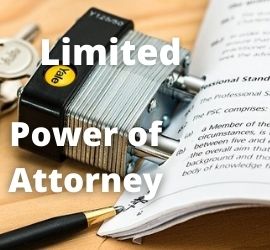What Is Limited Power of Attorney (LPOA)?
 A limited power of attorney (LPOA) legally appoints an agent to handle specific matters when the principal is unavailable or unable to do so.
A limited power of attorney (LPOA) legally appoints an agent to handle specific matters when the principal is unavailable or unable to do so.
For stock traders and brokers, it is an authorization that permits a portfolio manager to perform specific functions on behalf of the account owner. In general, the LPOA allows the manager to execute routine investment details and related business matters without contacting the account holder. Before signing an LPOA, the client should be aware of the specific functions they have delegated to the portfolio manager. Ultimately, the client remains liable for the decisions.
When creating a limited power of attorney, you are granting an agent the legal authority to act on your behalf. Under a general power of attorney, your agent has the authority to act on all matters. A limited power of attorney, on the other hand, limits the scope of your agent’s powers to a specific action or set of actions. Most brokers and portfolio managers execute investment-related details through a limited power of attorney.
Limited Power of Attorney – A Closer Look
LPOA authorizations have become more common in recent years. Many investors are choosing online money management firms and registered investment advisors (RIAs) over traditional brokerage firms. A limited power of attorney, as opposed to a general power of attorney, restricts the authority of the agent to a specific matter or purpose. For example, a portfolio manager can be empowered to execute an investment strategy as agreed upon with the account holder. An LPOA gives the portfolio manager the authority to buy and sell assets, pay fees, and handle various necessary forms. Certain critical account functions still can be made only by the account holder. For example, cash withdrawals and a change of beneficiary. A client can clearly state which other powers they may wish to retain at the time the account is set up.
A principal does not need to choose a lawyer to be their agent. An agent in fact can be very different from an attorney at law. Instead, a principal can grant limited power of attorney to any adult that they choose as their agent.
Limited Power of Attorney Scope and Limits
People can create a power of attorney for a variety of reasons. Some create powers of attorney specifically for times of incapacity, others for times of unavailability. A limited power of attorney enables you to have a trusted person act on your behalf for you on a specific matter. For example, signing a contract when you are unavailable to do so yourself.
A limited attorney (LPOA) power is also handy for more complex matters, like selling property or handling investments. In those situations, you would grant your agent the powers to make decisions and execute documents on your behalf. As a matter of fact, it is common for investment advisors to have their clients sign an LPOA granting them the authority to manage their investments.
In addition to restricting an agent’s power to act on certain matters, a limited power of attorney can restrict the timeframe that the agent is allowed to act. For example, you may be out of the country on vacation for a month, but wish to have someone back home able to sign business documents on your behalf. You would create an LPOA just for that month. (Source: info.legalzoom.com)
Limited Power of Attorney Types
There are variations on the limited power of attorney that may be used in special circumstances:
- Springing Powers: An LPOA with springing powers becomes active only if triggered by a specific event, usually the death or incapacitation of the account owner. They are commonly used in conjunction with a will or trust. For example, a springing LPOA can be triggered at the time that you become unable to make decisions for yourself (incapacitated) or at your death. Until either of these events occur, the agent has no authority to act on your behalf.
- Durable: Durable LPOAs give the portfolio manager continuing authority to perform certain functions even if the client dies or becomes incapacitated. A durable LPOA gives an agent the authority to act on the client’s behalf for specific matters for an unlimited amount of time.
- Non-Durable: The majority of LPOAs are non-durable, which means they become void when the client dies or becomes disabled. Unlike a durable LPOA, a non-durable LPOA expires when the client dies or becomes incapacitated.
How to Create a Limited Power of Attorney
In an LPOA document, the principal should clearly detail the specific powers granted to the agent. Often, the principal will define those powers that they wish to retain for themselves. The more complex the responsibilities, the greater detail that is required in the document. There is a fine line between providing too much detail vs not enough. The agent must be given proper information and power to carry out the instructions, without overstepping his proper authority.
In general, a limited power of attorney document must be signed, dated, and witnessed either by another person or a notary. Ultimately, it depends on the state of execution, laws or statutes, and the specific circumstances. Be sure to check with the laws in your state regarding the formalities required when drafting an LPOA. (Source: ibid)
Choose the LPOA Form for your state of residence
- Choose the proper form – Choose the limited power of attorney form made for your state. As a legal document, a limited power of attorney is subject to the laws in the state of your residency.
- Input personal information – Provide information about both the principal and the agent or attorney-in-fact. As the person creating the document you’re the principal. The person who will make decisions on your behalf is known as the agent. You’ll need to use your legal name, your address (including city, state, and zip code), the legal name of the agent, the agent’s full address (including city, state, and zip code), and their phone number. As the principal, you are not required to put your social security number in the document. However, you’ll need to provide some information that helps validate your identity.
- Explain the powers of the agent – Because this is a limited power of attorney, it is very important that you clearly and explicitly state what the agent may do on your behalf. Keep in mind that some activities may require verification of both the agent’s identity and your identity. For example, if your agent has the power to handle state or federal tax matters on behalf of you or your business, the limited power of attorney may need to include information such as your social security number, your EIN if you own a business, and other pertinent information.
- Specify the timeframe – Include the date the limited power of attorney expires or will be revoked. Generally, a limited power of attorney has a specific day it starts and a specific day it ends. However, there are other ways that the document may expire. For example, the principal revokes it prior to its expiration, once the listed activities are completed.
LPOA Agent Acceptance and Governing State Laws
- Governing state laws – List the state whose laws will be used to govern the agreement. This is generally the state in which you, the principal, are a resident.
- Agent acceptance – The agent completes an acceptance of appointment clause. This is only required in certain states. This clause is placed below the principal’s signature. The agent is accepting their position as the agent. It is signed by the agent.
- LPOA execution – Properly execute the limited power of attorney according to your state laws. Depending on the state in which you live, you may need to sign and date the limited power of attorney in the presence of witnesses or a notary. Even if you live in a state where a notary isn’t required to execute the document, notarizing it can be helpful as it helps prove the validity of the document if necessary.
LPOA for Financial and Portfolio Managers
Clients typically complete a power of attorney (POA) form when they open an account with a portfolio manager. Most forms give clients the option to choose between an LPOA or a full power of attorney. The client must designate an attorney in fact, who is usually the portfolio manager. The portfolio manager does NOT need to be an actual attorney to perform the function of an agent. Other portfolio managers who may make investment decisions on behalf of the client must also have their details provided on the form. Once completed, both the client and the attorney or attorneys in fact must sign the form.
Difference between: Attorney-in-Fact vs. Attorney-at-Law vs. Power of Attorney
- Power of Attorney is a document, not a person.
- Attorney in Fact is the person named as the agent in a Power of Attorney. It is incorrect, although done all the time, for a person to say “I am so-and-so’s Power of Attorney.” In reality, they are his or her Attorney in Fact under his or her Power of Attorney.
- Attorney at Law – Someone authorized to practice law; a lawyer. Also called attorney and public attorney.
Limited Power of Attorney – Final Words
A client who is uncertain or uncomfortable about what functions they are authorizing may want to get an attorney at law to review the LPOA form before signing it.
Up Next: What Is a Sine Wave?
 A sine wave is a geometric curve with a smooth, continuous, periodic oscillation. For traders, it indicates if a market is trending or in a cyclic mode.
A sine wave is a geometric curve with a smooth, continuous, periodic oscillation. For traders, it indicates if a market is trending or in a cyclic mode.
Sine waves are used in technical analysis and stock trading to help identify patterns. As an analytical trading tool, they indicate if a market is trending or in a cycle mode. It helps traders identify the start and finish of a trending move as well as possible shifts and crossovers in the trend.
A sine wave oscillates. This means it moves up, down, or side-to-side in a repetitive pattern. Mathematically, it is defined by the function y = sin x. When graphed, it is an s-shaped, smooth wave that oscillates above and below zero. Sine waves are used in technical analysis and financial trading to help identify patterns and cross-overs related to oscillating price and market trends.




